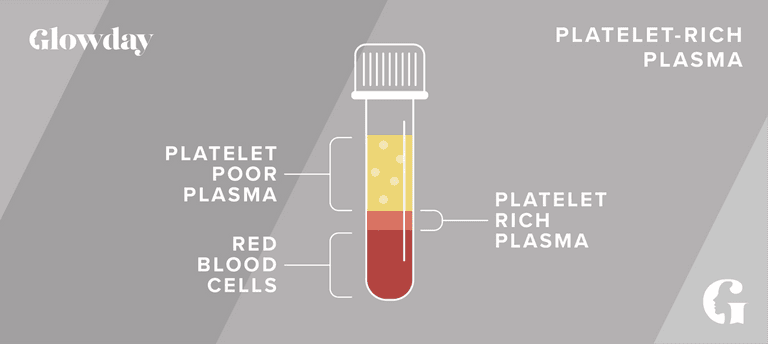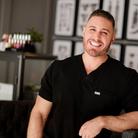PRP For Hairloss - At A Glance
Top Questions
What is PRP therapy for hairloss?
PRP (platelet-rich plasma) therapy has been used widely in orthopaedic and sports medicine to treat muscle and ligament injuries. More recently it has been adopted as a cosmetic treatment to treat signs of ageing and hairloss.
In 2013, Kim Kardashian made PRP famous when she posted a rather gruesome photo of her blood-covered face on Instagram. What followed was an explosion in customers asking for this treatment.
Blood contains platelets. Not only are platelets important in helping blood clot, but they also contain important proteins called growth factors. These growth factors are potent triggers for many of the processes involved in cell growth and wound healing. PRP for hairloss utilises the regenerative properties of growth factors and other proteins within the platelets to stimulate hair follicles, promote hair growth, and improve the overall health of the scalp.
PRP for hairloss involves drawing a small amount of the patient's blood, processing it to concentrate the platelets, and then injecting this platelet-rich plasma into the scalp.
The PRP procedure typically involves the following steps:
Blood Draw: A small amount of the patient's blood is drawn, usually from the arm.
Centrifugation: The blood is then processed in a centrifuge machine to separate the platelet-rich plasma from other components of the blood.
Preparation: The concentrated PRP is collected and prepared for injection.
Injection: The PRP is then injected into the areas of the scalp where hair loss is a concern.

PRP for hair loss is often used as a complementary or adjunctive therapy, and its effectiveness can vary among individuals. Some studies suggest that PRP may have a significantly positive impact on hair growth, while others have shown more mixed results. It's important to note that PRP is not a guaranteed solution for hair loss, and individual responses can vary.
This Glowday Treatment Guide has been edited and medically verified by Dr Ed Robinson.
How does PRP for hairloss work?
PRP therapy for hairloss utilises the growth factor proteins within your own blood to improve the health of the hair follicles in your scalp.
Your blood will be taken, and the platelet-rich plasma will be harvested. This component of the blood contains proteins called ‘growth factors’.
When injected into target areas of your scalp or applied to skin that has been intentionally injured during treatments like microneedling, these proteins increase hair follicle renewal and repair.
The growth factors found in the PRP solution are believed to stimulate dormant or weakened hair follicles, prolong the hair growth cycle, and potentially increase the thickness of existing hair. The improved blood supply to the scalp is also thought to contribute to better hair health.
What are the benefits of PRP for hairloss?
Platelet-Rich Plasma (PRP) therapy for hair loss is one among several treatments available. Here are some potential advantages and considerations of PRP therapy compared to other treatments:
Natural Growth Factors:
PRP therapy utilizes the patient's own blood to extract platelet-rich plasma, which contains natural growth factors and proteins. Some people appreciate the idea of using their body's natural substances for treatment.
Minimally Invasive:
PRP injections are considered minimally invasive compared to surgical hair restoration procedures like hair transplants. There is no need for incisions or stitches, reducing the risk of complications.
No Allergic Reactions:
Since PRP is derived from the patient's own blood, the risk of allergic reactions is minimal. This can be an advantage for individuals who may be sensitive or allergic to certain medications or foreign substances.
Quick Recovery:
PRP therapy typically has a quick recovery time. Patients can usually resume their normal activities shortly after the procedure, making it a convenient option for those with busy schedules.
Adjunctive Treatment:
PRP therapy can be used as an adjunctive treatment alongside other hair loss interventions, such as topical medications, oral medications or treatments like polynucleotides. This combination approach may enhance the overall efficacy of the treatment.
Early Stage Hair Loss:
Some studies suggest that PRP may be more effective in the early stages of hair loss. It is believed to stimulate dormant hair follicles and improve the overall health of existing hair.
However, it's essential to consider that the effectiveness of PRP therapy can vary among individuals, and it may not be a suitable option for everyone.
How do you prepare for PRP therapy for hairloss?
1 week prior to your PRP treatment, you should avoid taking NSAIDs (unless prescribed by your GP. Please speak with your practitioner if this applies).
You should ideally avoid drinking alcohol a week before your treatment and definitely not binge drink prior to your appointment as this temporarily depletes your platelets, which can reduce the benefits of the treatment.
Other than that, there are no specific steps to take - unless you are combining PRP therapy with microneedling or laser treatments.
It is a good idea to arrive at your appointment with thoroughly cleansed hair and scalp, with no hair products.
What will happen during a PRP for hairloss treatment?
Step One - Consultation and Consent
It is important to understand that, whilst PRP therapy is not a prescription-based treatment, choosing a medically qualified practitioner is best since blood will need to be drawn from your arm. Medically trained practitioners will also use medical needling devices that penetrate deeper into the skin than non-medically qualified practitioners.
Step Two - The PRP Treatment
What happens during your treatment depends on whether you are combining PRP therapy with other complementary treatments or not.
Additionally, your practitioner may offer topical numbing of the treatment area.
If you're concerned about the potential discomfort, some practitioners are qualified to administer a scalp nerve block using four local anaesthetic injections. This numbs the whole scalp for the duration of the treatment.
Step Three - Repeat Treatments
Improvements in your skin will be visible within a few weeks.
Depending on the advice given by your practitioner, you may be advised to book a course of treatments - usually 4-6, at least 8 weeks apart. Alternatively, a specific maintenance programme might be recommended.
What should I do after PRP therapy for hairloss?
Do:
- Avoid the sun
- Avoid sunscreen immediately after
- Use collagen-stimulating peptides
- Keep hydrated
Don’t:
- Use harsh haircare products until recommended by your practitioner - usually 5 days post-treatment
- Use heat styling tools until recommended by your practitioner
- Do strenuous exercise for 24-48 hours - sweating can enable bacteria to enter the channels created during the treatment
What are the side effects and risks of PRP therapy for hairloss?
Your scalp is likely to appear red and feel more sensitive post-treatment. You may feel a little sore, tight and uncomfortable for around 48 hours. Any swelling, itchiness and redness should subside within a few days.
Additionally, because the injections contain your own blood products, there is less risk of an allergic reaction. There is a risk of infection, however, so using a medically qualified, appropriately trained practitioner is essential. It's important that you follow the aftercare advice given to you, to ensure your scalp heals well.
While Platelet-Rich Plasma (PRP) therapy for hairloss is generally considered safe, there are certain situations in which it may not be suitable or may require careful consideration. PRP therapy may not be recommended for individuals in the following cases:
Medical Conditions:
People with certain medical conditions or blood disorders may not be suitable candidates for PRP therapy. Conditions such as chronic liver disease, platelet dysfunction syndromes, thrombocytopenia, hemodynamic instability, and systemic disorders that affect platelet function may contraindicate PRP therapy.
Active Infections or Skin Diseases:
PRP therapy involves injections into the scalp, and it may not be advisable for individuals with active infections or skin diseases in the treatment area. The injection process could potentially exacerbate these conditions.
Recent Use of Blood Thinners:
If a person has been taking blood-thinning medications or antiplatelet drugs, the physician may need to evaluate whether it is safe to discontinue them temporarily before the PRP procedure. It's important to discuss all medications with the healthcare provider.
Pregnancy and Breastfeeding:
PRP therapy is generally not recommended for pregnant or breastfeeding individuals due to the potential impact on fetal development or the transfer of substances to the infant through breast milk.
Allergies or Sensitivities:
Individuals with known allergies to components of the PRP preparation, such as anticoagulants or other additives, may not be suitable candidates for PRP therapy.
Unrealistic Expectations:
PRP therapy may not be suitable for individuals with unrealistic expectations regarding the outcomes. While some people experience positive results, the extent of improvement can vary, and PRP is not a guaranteed solution for hair loss.
Severe Hair Loss:
PRP therapy may be more effective in the early stages of hair loss or for those with mild to moderate hair thinning. In cases of advanced or severe hair loss, other interventions like hair transplants may be more appropriate.
Inability to Undergo the Procedure:
Individuals who are unable to tolerate injections or have a fear of needles may find the procedure uncomfortable, and alternative treatments may be more suitable for them.
It's crucial for individuals considering PRP therapy to undergo a thorough consultation with a qualified healthcare professional. The healthcare provider will assess the individual's medical history, current health status, and the specific characteristics of their hair loss to determine the suitability of PRP therapy or recommend alternative treatments if necessary.
How much does PRP therapy for hairloss cost?
The cost of PRP therapy for hairloss will vary depending on the treatment and location.
As a guide, you should expect to pay £450 per PRP hairloss treatment
Glowday Disclaimer
All information in our Glowday Treatment Guides and blog articles is intended for reference and information. The information given here is to help you make informed decisions when considering the wide range of non-surgical aesthetic treatments available.
It is NOT intended as medical advice. Any reliance placed by you on the information contained within the Glowday Treatment Guides, Glowday blog articles or on any of Glowday.com is done by you at your own risk.
Before undergoing any non-surgical cosmetic treatment mentioned anywhere on Glowday.com, you should fully consult with an appropriately qualified and accredited practitioner who is properly trained in and fully insured to conduct the treatment you are interested in. Neither the author of the guides or blog articles, or the practitioner who has verified the guides nor Glowery Limited can be held responsible or liable for any loss or claim arising from the use or misuse of the content of Glowday.com.

